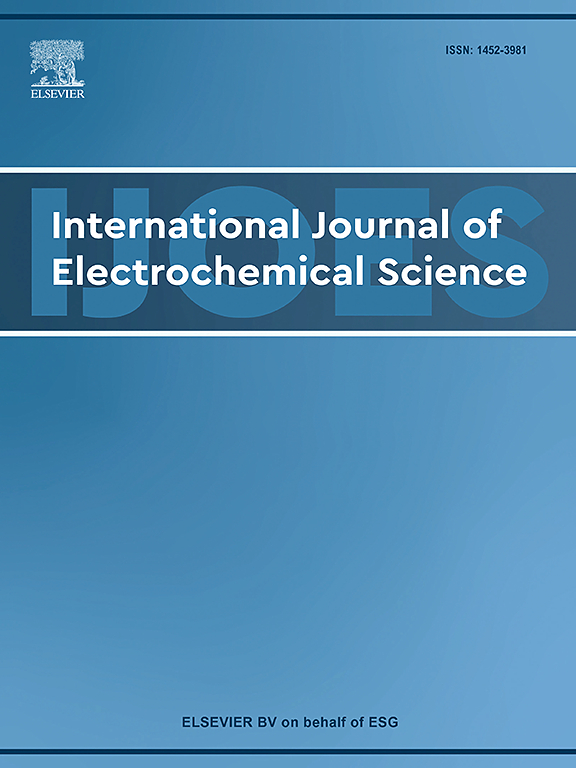Inhibitory effect of novel synthesized imidazolone-derived heterocyclic compounds on mild steel corrosion in hydrochloric acid: Electrochemical, surface analysis, and theoretical studies
IF 1.3
4区 化学
Q4 ELECTROCHEMISTRY
International Journal of Electrochemical Science
Pub Date : 2025-04-12
DOI:10.1016/j.ijoes.2025.101026
引用次数: 0
Abstract
This study focuses on the inhibitory effect of novel synthetized imidazolone-derived heterocyclic compounds, namely 5,5-diphenyl-2-(2-(pyridin-2-ylmethylene)hydrazineyl)-3,5-dihydro-4H-imidazol-4-one (IMID2) and (E)-5,5-diphenyl-2-(2-(pyridin-3-ylmethylene)hydrazineyl)-3,5-dihydro-4H-imidazol-4-one (IMID3) on mild steel (MS) corrosion in 1.0 M HCl solution using electrochemical studies, surface and elementary composition analyses with scanning electronic microscopy (SEM) coupled with energy dispersive X-ray (EDX) and theoretical studies based on Density Functional Theory (DFT) calculation and Molecular Dynamic (MD) simulations. Firstly, these products were prepared and identified using FT-IR, 1H NMR and 13C NMR. Electrochemical impedance spectroscopy (EIS) results indicated that the inhibition efficiency of IMID2 and IMID3 depends on their concentrations and the –N positions in their structures. So, this inhibition efficiency reaches up to 94.85 % and 92.02 % at 10−3 M IMID2 and IMID3, respectively. In addition, the potentiodynamic polarization (PDP) results indicated that these compounds react as cathodic mixed-type inhibitors. Moreover, it is found that the IMID2 and IMID3 inhibitors react via Langmuir isotherm adsorption, which is a confirmed SEM/EDX examination by the establishment of a defensive layer on the MS area. The effect of the temperature solution indicated that the IMID3 and IMID2 take their performance at high temperature. The DFT calculation showed that IMID3 and IMID2 interact with MS area via their heteroatoms and aromatic rings, where IMID2 exhibits superior inhibition properties. Finally, MD simulation indicated that these molecules adopt a horizontal orientation upon adsorption, promoting optimal contact with the MS surface and confirm the performance inhibition of IMID2 than IMID3.
新型合成咪唑杂环化合物对盐酸中低碳钢腐蚀的抑制作用:电化学、表面分析和理论研究
研究了新合成的咪唑酮类杂环化合物5,5-二苯基-2-(2-(吡啶-2-基亚甲基)肼基)-3,5-二氢- 4h -咪唑-4-酮(IMID2)和(E)-5,5-二苯基-2-(2-(吡啶-3-基亚甲基)肼基)-3,5-二氢- 4h -咪唑-4-酮(IMID3)在1.0 M HCl溶液中对低碳钢(MS)腐蚀的抑制作用。利用扫描电子显微镜(SEM)和能量色散x射线(EDX)进行表面和基本成分分析,以及基于密度泛函理论(DFT)计算和分子动力学(MD)模拟的理论研究。首先,利用FT-IR、1H NMR和13C NMR对这些产物进行了制备和鉴定。电化学阻抗谱(EIS)结果表明,IMID2和IMID3的缓蚀效率与它们的浓度和结构中的-N位置有关。因此,在10−3 M的IMID2和IMID3中,抑制率分别达到94.85 %和92.02 %。此外,电位极化(PDP)结果表明,这些化合物反应为阴极混合型抑制剂。此外,发现IMID2和IMID3抑制剂通过Langmuir等温吸附反应,这是通过在MS区域建立防御层的SEM/EDX检查证实的。温度溶液的影响表明,IMID3和IMID2在高温下仍能保持其性能。DFT计算表明,IMID3和IMID2通过杂原子和芳香环与质谱区相互作用,其中IMID2表现出更好的抑制性能。最后,MD模拟表明,这些分子在吸附时采用水平取向,促进了与MS表面的最佳接触,并证实了IMID2的抑制性能优于IMID3。
本文章由计算机程序翻译,如有差异,请以英文原文为准。
求助全文
约1分钟内获得全文
求助全文
来源期刊
CiteScore
3.00
自引率
20.00%
发文量
714
审稿时长
2.6 months
期刊介绍:
International Journal of Electrochemical Science is a peer-reviewed, open access journal that publishes original research articles, short communications as well as review articles in all areas of electrochemistry: Scope - Theoretical and Computational Electrochemistry - Processes on Electrodes - Electroanalytical Chemistry and Sensor Science - Corrosion - Electrochemical Energy Conversion and Storage - Electrochemical Engineering - Coatings - Electrochemical Synthesis - Bioelectrochemistry - Molecular Electrochemistry

 求助内容:
求助内容: 应助结果提醒方式:
应助结果提醒方式:


